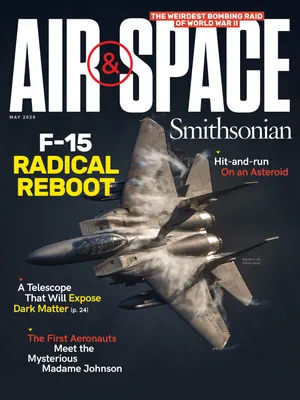How the Curtiss P-40 Got That Wicked Shark Grin
The Tomahawk was not the first airplane to wear its trademark nose art.
:focal(360x596:361x597)/https://tf-cmsv2-smithsonianmag-media.s3.amazonaws.com/filer/21/8d/218d4a04-1420-4772-9449-605b5fdd9239/07a_am2020_112squadronnevillebowksbowker_live.jpg)
It isn’t a smile. It is more a predator’s sneer. Razor teeth, wagging tongue, and a 300-yard stare from black, dead eyes, focused at the spot where the warplane’s guns converge. The airplane nose art presented the face of aggression, a bit of psychological warfare intended to intimidate, created with a few ounces of paint slathered on aluminum.
World War II’s legendary American Volunteer Group, the “Flying Tigers,” made the shark mouth famous, but they weren’t the first to paint it on airplanes. During World War I, a few German pilots painted eyes and a closed-mouth frown on their Roland C.II reconnaissance aircraft. They called their fat-bellied Roland biplanes Walfische (Whales). The nose art was jocular and seemed appropriate for such tubby machines. It appeared to carry an expression more of grim determination than of real acrimony. Soon after, someone decided to add an open mouth and triangular teeth to the ensemble, giving one of the aircraft a deranged smirk.
No good idea stays a secret for long. A multitude of machines from World War I and beyond carried on the motif, which appeared on Nieuports, Sopwiths, and later, Messerschmitts, to name just a few.
/https://tf-cmsv2-smithsonianmag-media.s3.amazonaws.com/filer/a9/90/a99025b4-52d4-447f-a970-873ea2f74c2f/07d_am2020_three_si-2005-15700_live_edit.jpg)
And then came the Curtiss P-40. Straight out of the factory, the fighter looked like it had a menacing maw because of its substantial inlet scoop situated under a piked nose. Today, it’s hard to think of a Tomahawk without those hungry jaws going along for the ride. Even a three-year-old will tell you, “That’s a Flying Tiger,” and the contradiction inherent in a tiger wearing the face of a shark seems not to trouble anyone. But not all World War II shark-face P-40s are Flying Tigers.
By the time U.S. pilots were flying combat in World War II, Royal Air Force fliers were veterans of almost two years of war. The Americans adopted many British theories of how to fight effectively in the air and took other things as well, including 100 Tomahawk fighters that had been destined for Britain. Those airplanes were the ones flown by the AVG.
The archetypal shark mouth, as we know it today, first appeared on the noses of the Tomahawks of Royal Air Force No. 112 Squadron, fighting in North Africa. “The Shark Squadron” had received its Curtiss fighters in July 1941. Squadron nose art underwent many iterations before the British airmen settled on the definitive design. The ultimate shark appeared while 112 Squadron was serving in Egypt.
That year, in another part of the world—a Baptist missionary’s house in Toungoo, Burma, to be exact—AVG pilot Charles Bond had grown bored with the after-dinner conversation. He picked up the November 2, 1941 copy of The Illustrated Weekly of India and saw, on its cover, a photo of a pair of 112 Squadron’s Tomahawks. In the photo, South African Flight Lieutenant Neville “Bowks” Bowker stood on the wing of a British Tomahawk Mk. 1 named “Menace.” But what struck Bond most was the fighter’s eyes and fearsome teeth.
“Gee!” he wrote in his diary, “I want my P-40 to look like that! I discussed it with the others and they thought it was a good idea.” Bond hoped to mark all the fighters of the First Pursuit Squadron with the design, however, AVG commander Claire Chennault said, “No.” Instead, he wanted every airplane in the entire group to carry the markings. On the following day, Bond wrote in his diary, “November 16, 1941. Quite sore today. I suppose it was from pedaling into town for the paint to jazz up the planes.”
Soon, many pilots and ground crewmen were pitching in. After several days of laying out nearly the exact British pattern with chalk, then painting teeth and eyes onto each aircraft, the crews stepped back to admire their work. AVG pilot and memoirist R.T. Smith surely spoke for all the Flying Tigers when he said, “That looks mean as hell.”
